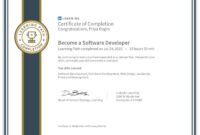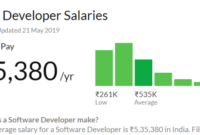3 nightmare interviews for software developers – Have you ever felt your stomach drop when you realize the interview you’re about to face is going to be a real challenge? For software developers, there are a few interview formats that are notorious for their difficulty, and these can feel like walking into a minefield of technical questions and pressure-filled scenarios.
These “nightmare” interviews can range from the dreaded whiteboard coding challenge to the daunting open-ended design interview, leaving even the most experienced developers feeling anxious.
This post dives into three common interview formats that can be particularly challenging for software developers: the whiteboard challenge, the open-ended design interview, and the technical deep dive. We’ll explore the potential pitfalls of each format, provide tips for navigating these challenges, and discuss why these interviews are often seen as “nightmares” by many developers.
The “Whiteboard Challenge”

The “whiteboard challenge” is a common practice in software development interviews where candidates are asked to solve a coding problem on a whiteboard in real-time. This practice aims to assess a candidate’s problem-solving skills, coding proficiency, and ability to think critically under pressure.
Enhance your insight with the methods and methods of europe take note france bans short haul flights.
Common Whiteboard Challenges
Whiteboard challenges often involve solving problems related to data structures and algorithms. Here are some common examples:
- Reverse a Linked List: This problem involves reversing the order of nodes in a linked list data structure. This challenge assesses a candidate’s understanding of linked lists, pointers, and iterative or recursive approaches.
- Find the Median of Two Sorted Arrays: This problem requires finding the median value of two sorted arrays. This challenge tests a candidate’s understanding of binary search, divide-and-conquer strategies, and efficient algorithms for handling sorted data.
- Implement a Queue Using Two Stacks: This problem involves implementing a queue data structure using only two stacks. This challenge assesses a candidate’s understanding of stack and queue data structures, their operations, and how to simulate one using another.
- Two Sum Problem: Given an array of integers, find two numbers that add up to a specific target value. This problem tests a candidate’s understanding of array manipulation, hash tables, and efficient search algorithms.
Potential Pitfalls of Whiteboard Interviews
While whiteboard interviews can be a valuable tool for assessing coding skills, they also present potential pitfalls:
- Stress and Pressure: The real-time nature of whiteboard interviews can be stressful for candidates, especially under the pressure of being observed by interviewers. This can lead to performance anxiety and difficulty thinking clearly.
- Lack of Context and Real-World Relevance: Whiteboard challenges often lack the context and complexity of real-world software development tasks. This can make it difficult for candidates to apply their knowledge and experience effectively.
- Focus on Syntax and Perfection: Whiteboard interviews often emphasize syntax and code correctness over the overall design and solution approach. This can lead to candidates overlooking important aspects of software development, such as code readability, maintainability, and efficiency.
- Limited Scope for Collaboration: In a real-world development environment, collaboration is crucial. However, whiteboard interviews typically focus on individual performance, limiting the opportunity for collaboration and teamwork.
Tips for Preparing for and Navigating Whiteboard Challenges, 3 nightmare interviews for software developers
Here are some tips for preparing for and navigating whiteboard challenges:
- Practice Regularly: Practice solving coding problems on a whiteboard to become comfortable with the format and develop your problem-solving skills. Utilize online platforms like LeetCode, HackerRank, and Codewars to access a wide range of practice problems.
- Master Fundamental Data Structures and Algorithms: A strong understanding of data structures and algorithms is essential for whiteboard challenges. Familiarize yourself with common data structures like arrays, linked lists, stacks, queues, trees, and graphs, and practice implementing algorithms for searching, sorting, and other common operations.
- Communicate Clearly and Effectively: During the interview, communicate your thought process and solution approach clearly to the interviewer. Explain your reasoning behind each step and ask clarifying questions if needed. This demonstrates your ability to think critically and collaborate effectively.
- Focus on Design and Solution Approach: While syntax and code correctness are important, focus on the overall design and solution approach. Explain your reasoning behind your choice of data structures and algorithms and consider the trade-offs between different approaches.
- Don’t Panic: Remember that whiteboard challenges are just one aspect of the interview process. If you get stuck, don’t panic. Ask for clarification, break down the problem into smaller parts, and communicate your thought process to the interviewer.
The “Open-Ended Design Interview”
This type of interview assesses a candidate’s ability to think critically, design solutions, and communicate their ideas effectively. Instead of focusing on specific technical skills, open-ended design interviews challenge developers to tackle complex problems by designing systems or features from scratch.
Examples of Open-Ended Design Questions
These questions require candidates to demonstrate their understanding of system architecture, trade-offs, and design principles.
- Design a social media platform for a specific niche audience.
- Design a distributed database system that can handle millions of requests per second.
- Design a real-time chat application that scales to millions of users.
- Design a recommendation engine for a streaming service.
Importance of Communication, Problem-Solving, and Design Patterns
Effective communication is crucial in open-ended design interviews. Candidates must be able to articulate their ideas clearly, explain their design choices, and answer questions from the interviewer. Problem-solving skills are essential for breaking down complex problems into smaller, manageable components and finding creative solutions.
Design patterns provide a framework for structuring solutions and addressing common design challenges.
Tips for Approaching Open-Ended Design Questions
- Start with a clear understanding of the problem: Ask clarifying questions to ensure you understand the requirements and constraints.
- Identify key stakeholders and their needs: Consider the different users and their expectations.
- Break down the problem into smaller components: This will help you design a solution incrementally.
- Use design patterns and best practices: Leverage existing patterns and principles to guide your design.
- Communicate your design clearly and concisely: Use diagrams, flowcharts, and other visual aids to explain your solution.
- Be prepared to discuss trade-offs: Every design decision comes with pros and cons. Be ready to explain your choices and the rationale behind them.
- Ask for feedback and iterate: Be open to suggestions and feedback from the interviewer.
The “Technical Deep Dive”: 3 Nightmare Interviews For Software Developers
The “Technical Deep Dive” interview is a common practice in the software development hiring process. It goes beyond the typical “tell me about yourself” questions and delves into the specific technical expertise of the candidate. This interview format allows the interviewer to gauge a candidate’s depth of knowledge in a specific area and their ability to apply that knowledge in real-world scenarios.
Technical Deep Dive Questions
This type of interview often involves a series of questions focused on a specific programming language, framework, database, or other technical area relevant to the job. These questions can be theoretical, asking for explanations of core concepts, or practical, requiring the candidate to demonstrate their ability to solve problems using the chosen technology.
- Example 1: Programming Language “Explain the difference between pass-by-value and pass-by-reference in [programming language] and provide an example of how each works.”
- Example 2: Framework “Describe the MVC architecture pattern and how it’s implemented in [framework]. Provide an example of how you would use it to build a specific feature.”
- Example 3: Database “Explain the difference between a relational database and a NoSQL database. What are the advantages and disadvantages of each? When would you choose one over the other?”
Demonstrating Technical Proficiency
During a technical deep dive interview, it’s crucial to demonstrate a deep understanding of the chosen technology. This means being able to explain complex concepts clearly and concisely, providing real-world examples to illustrate your understanding, and confidently discussing trade-offs and best practices.
It’s also important to show a willingness to learn and adapt to new technologies, as the software development landscape is constantly evolving.
Preparing for a Technical Deep Dive Interview
To excel in this type of interview, it’s essential to prepare thoroughly.
- Review Your Resume Start by carefully reviewing your resume and identifying the technical skills and experience highlighted. Focus on the areas that are most relevant to the job you’re applying for.
- Practice Answering Common Questions Prepare for common technical deep dive questions by researching and practicing your answers. This can include reviewing online resources, working through practice problems, and even having a mock interview with a friend or mentor.
- Demonstrate Your Passion Beyond technical knowledge, interviewers are also looking for candidates who are passionate about technology and eager to learn. Showcase your enthusiasm by discussing projects you’ve worked on, side projects you’ve pursued, or areas of technology that you’re particularly interested in.





